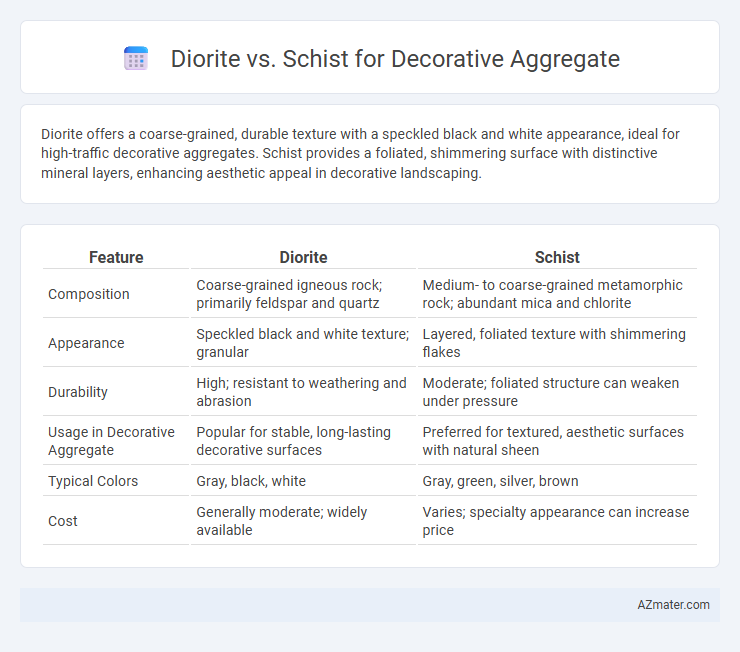Diorite offers a coarse-grained, durable texture with a speckled black and white appearance, ideal for high-traffic decorative aggregates. Schist provides a foliated, shimmering surface with distinctive mineral layers, enhancing aesthetic appeal in decorative landscaping.
Table of Comparison
| Feature | Diorite | Schist |
|---|---|---|
| Composition | Coarse-grained igneous rock; primarily feldspar and quartz | Medium- to coarse-grained metamorphic rock; abundant mica and chlorite |
| Appearance | Speckled black and white texture; granular | Layered, foliated texture with shimmering flakes |
| Durability | High; resistant to weathering and abrasion | Moderate; foliated structure can weaken under pressure |
| Usage in Decorative Aggregate | Popular for stable, long-lasting decorative surfaces | Preferred for textured, aesthetic surfaces with natural sheen |
| Typical Colors | Gray, black, white | Gray, green, silver, brown |
| Cost | Generally moderate; widely available | Varies; specialty appearance can increase price |
Introduction to Decorative Aggregates
Diorite and schist are popular choices for decorative aggregates due to their unique textures and visual appeal in landscaping and architectural projects. Diorite offers a coarse-grained, speckled appearance with durability and resistance to weathering, making it ideal for pathways and garden accents. Schist provides a layered, flaky texture with rich mineral composition that enhances aesthetic value while promoting natural drainage and erosion control in outdoor settings.
Overview of Diorite
Diorite is a coarse-grained igneous rock composed primarily of plagioclase feldspar and hornblende, making it highly durable and visually appealing for decorative aggregate uses. Its speckled texture ranges from light to dark gray, providing a sophisticated, natural look that enhances landscaping and architectural projects. Diorite's strength and resistance to weathering make it an ideal choice for high-traffic areas and outdoor installations.
Overview of Schist
Schist is a metamorphic rock characterized by its foliated texture and abundance of platy minerals like mica, which provide a distinctive shimmering appearance ideal for decorative aggregates. Its durability and ease of fracturing into flat slabs make schist a popular choice for landscaping, pathways, and garden features. The mineral composition and layered structure enable schist to offer a range of colors and aesthetic textures, enhancing the visual appeal of outdoor spaces.
Visual Appeal: Diorite vs Schist
Diorite offers a striking visual appeal with its coarse-grained texture and contrasting black and white mineral patterns, making it ideal for bold decorative aggregate applications. Schist features a foliated texture with a natural shimmer caused by mica content, providing a more refined and elegant look in landscaping or architectural accents. Choosing between diorite and schist depends on whether a dramatic or subtle aesthetic is desired for the decorative space.
Durability and Weather Resistance
Diorite exhibits superior durability and weather resistance compared to schist due to its dense, coarse-grained igneous composition, making it ideal for long-lasting decorative aggregate applications. Schist, a metamorphic rock with pronounced foliation, tends to be less resistant to weathering and may degrade faster when exposed to harsh environmental conditions. Choosing diorite ensures enhanced structural integrity and minimal maintenance in exterior landscaping and architectural projects.
Color and Texture Variations
Diorite offers a coarse-grained texture with a speckled appearance, featuring dark gray to black minerals contrasted with lighter feldspar, providing a striking visual for decorative aggregate. Schist presents a foliated texture marked by thin, parallel layers, often exhibiting shimmering mica flakes that reflect light, and showcases a diverse color range from gray and green to reddish hues. The color stability and subtle sparkle of schist make it ideal for elegant landscape designs, while diorite's bold contrast suits modern, rugged aesthetics.
Maintenance Requirements
Diorite offers low maintenance requirements for decorative aggregate due to its dense, hard composition which resists weathering and erosion over time. Schist, although visually appealing with its foliated texture, requires more frequent sealing and cleaning to prevent flaking and surface degradation in outdoor applications. Choosing diorite reduces long-term upkeep costs, making it ideal for high-traffic decorative aggregate usage.
Cost Differences
Diorite generally commands a higher price than schist due to its greater durability and aesthetic appeal in decorative aggregate applications. Schist, being more abundant and easier to quarry, often provides a cost-effective option for large landscaping projects. Cost differences also arise from regional availability, with transportation expenses significantly impacting final pricing for both materials.
Best Applications for Each Stone
Diorite, with its coarse-grained texture and durability, is ideal for high-traffic landscaping projects and driveways where strength and resistance to weathering are crucial. Schist offers a unique layered appearance and is best suited for decorative garden paths, rock gardens, and accent walls where its natural shimmer enhances visual appeal. Both stones provide excellent drainage properties, but diorite's hardness makes it preferable for structural uses while schist excels in aesthetic-focused applications.
Choosing Between Diorite and Schist
Diorite offers a durable, coarse-grained texture with a speckled black-and-white appearance, making it ideal for decorative aggregate requiring strength and visual contrast. Schist features a foliated structure with shimmering mineral layers, providing a unique, reflective quality suited for aesthetic landscaping and garden pathways. Selection between diorite and schist depends on desired durability and visual effect, with diorite excelling in structural applications and schist preferred for ornamental finishes.

Infographic: Diorite vs Schist for Decorative Aggregate
 azmater.com
azmater.com